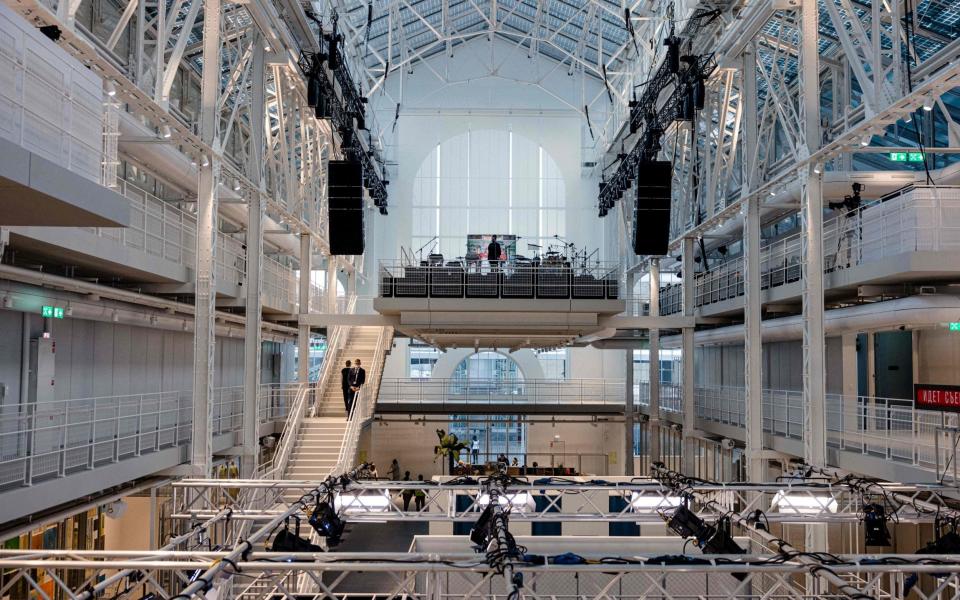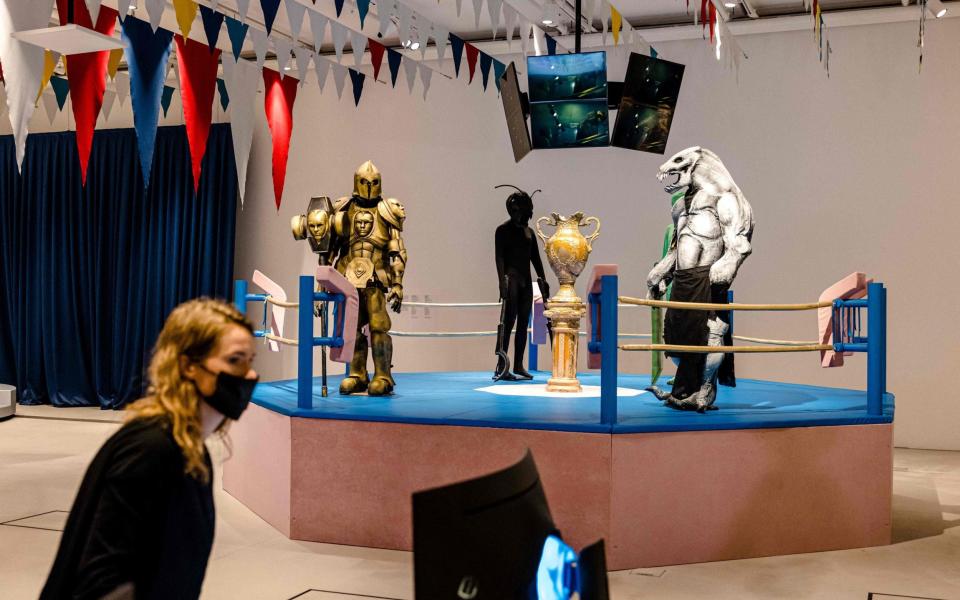Step inside GES-2, the world’s most beautiful fun palace

The grand opening of the spanking new GES-2 arts centre in Moscow last week was in many ways like the grand opening of a new “iconic” arts centre anywhere in the world. The art on display in the new spaces was totally international, the language used by the curators to describe it was the same peculiar contemporary art-speak you could hear from Beijing to Basel (I actually heard the word “post-ironic” uttered, without a trace of irony). The same champagne flowed, the same beautiful people greeted each other with air-kisses, the speech from the artistic director about this being a “culture house for ordinary people” brought forth the same polite applause.
And yet it soon became clear this was something very unusual. Normally on these occasions, a dignitary from the city council or culture ministry would step forward to say how pleased they were to contribute to the new building. Here, there was nobody. It was a forceful reminder that this arts centre owes its existence entirely to one man, who seemed to be invisible: Leonid Mikhelson, his personal wealth of $27 billion or so making him the richest of the Russian oligarchs and the 34th-richest person in the world.
Mikhelson’s real passion is art, and in particular Italian art. All the movers and shakers in this project are Italian: the director of Mikhelson’s art foundation Teresa Iarocci Mavica, the director of GES-2 Francesco Manacorda, and above all the architect Renzo Piano. The choice back in 2013 of an iconic disused power-station right next to the Kremlin as the Moscow base of the Foundation seems powerfully symbolic, but Teresa Mavica disclaims any intention to cosy up to power. “We were looking for a new model of a museum that could be like a house of culture for the people, like the Casa del Popolo in Italy. It should be always free to enter and a place people would feel belonged to them.”
No one at the Foundation or in Michelson’s entourage will say how much has been spent on renovating the building. But it must have cost hundreds of millions to convert the gaunt metal skeleton, filled with the grime and clapped-out machinery of a century of generating electricity, into the shimmering metal-and-glass palace that greets one’s eyes at the entrance. The colouring – in numerous shades of white and pale-grey, with original features picked out in green – is exquisite, and the labyrinth of raised metal walkways and staircases leading to unexpected new vistas is a miracle of engineering.
There are spaces to teach and to make every kind of art, including a gold-standard recording studio (where a few notes played on a piano by Vladimir Putin on his visit two days previously were reverently recorded). Having paid for the building, Mikhelson has undertaken to cover its running costs, through an endowment he has funded.

One of the pleasures of the new building is the way you keep encountering unexpected vistas. It’s an aspect of it that Manacorda says is deliberately built into the design. “One of our inspirations was the British architectural theorist Cedric Price, who in the 1970s elaborated these incredibly bold ideas for what he called the Fun Palace,” he says. “The essence of the building was that it would never be finished – it would keep changing its internal configuration according to how people want to use it.”
To prove his point, he leads me along a raised walkway until we come to a square metal platform with no walls, floating some metres above the “piazza”. “This space is a perfect metaphor for the whole building,” says Manacorda. “It could be used for concerts, as it has perfect sound which we designed with acousticians. Or it could be a space for theatre, or an installation.”
Walking back a few metres, I get a surprising glimpse into the galleries several floors below, which include among other things a brand-new work created by Icelandic artist Ragnar Kjartansson. Based on a largely forgotten American soap opera from the 1990s called Santa Barbara, it will engage 70 actors technicians and cameramen in daily re-recordings of one episode of the soap, which became massively popular with Russian audiences. It’s part of a big year-long season of installations, exhibitions and performances exploring Russian identity since the end of communism, under the tongue-in-cheek title “Holy Barbarians”. It’s exploring the ancient idea of carnival as an occasion when traditional heirarchies are upended, along with the idea of Moscow as a place of longing that cannot be reached, first expressed in Chekhov’s play Three Sisters.

Most eloquent of all the new spaces was the one that in the opening weekend stood entirely empty and silent: the platform for stand-up comedy. Comedy is the genre that has suffered more than any other in the recent government crackdown on the arts. Does Teresa Mavica see trouble ahead for GES-2, if artists step out of line?
“Politics is about the present, and I stopped believing in politics a long time ago,” she says defiantly. “I am interested in the future, which is why I believe in art. We are not here to fight political battles, we are here to imagine a better life, and we will do everything within the framework of the law.”
Whether her determination not to fight political battles will be shared by the artists who come to work in GES-2, and by the Kremlin politicians a few yards away across the Moscow river, remains to be seen. In the meantime, they and the people of Moscow can enjoy a wonderful new building which, as well as being a real-life fun palace, is also astonishingly beautiful.

